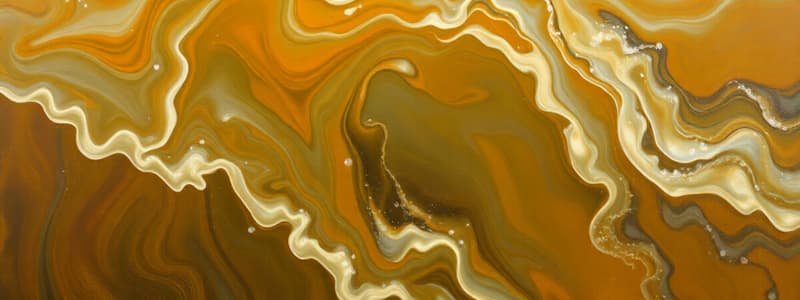Podcast
Questions and Answers
Which of the following best describes the primary difference between laminar and turbulent flow?
Which of the following best describes the primary difference between laminar and turbulent flow?
- Laminar flow is characterized by irregular, chaotic movement, while turbulent flow is smooth and parallel.
- Laminar flow features smooth, parallel movement, while turbulent flow is irregular and chaotic. (correct)
- Laminar flow only occurs in gases, while turbulent flow only occurs in liquids.
- Laminar flow involves higher resistance, while turbulent flow involves low resistance.
According to the particle theory, particles in solids vibrate but do not move freely, unlike those in liquids and gases.
According to the particle theory, particles in solids vibrate but do not move freely, unlike those in liquids and gases.
True (A)
Explain how temperature affects fluid flow rate based on the particle theory.
Explain how temperature affects fluid flow rate based on the particle theory.
Higher temperature increases particle movement, which lowers viscosity and results in the fluid flowing faster.
The study of how gases move around objects is known as ______.
The study of how gases move around objects is known as ______.
Match the fluids in the human body with their primary function:
Match the fluids in the human body with their primary function:
Which of the following statements accurately describes the relationship between viscosity and flow rate?
Which of the following statements accurately describes the relationship between viscosity and flow rate?
According to the particle theory, particles do not attract each other.
According to the particle theory, particles do not attract each other.
What is the definition of flow rate, and what are two common units used to measure it?
What is the definition of flow rate, and what are two common units used to measure it?
The study of liquids, including water, and how they move around objects is known as ______.
The study of liquids, including water, and how they move around objects is known as ______.
Match the following concepts with their definitions:
Match the following concepts with their definitions:
Considering adhesion and cohesion, which combination would most likely result in a slow flow rate?
Considering adhesion and cohesion, which combination would most likely result in a slow flow rate?
According to particle theory, the amount of space between particles doesn't vary between solids, liquids and gases.
According to particle theory, the amount of space between particles doesn't vary between solids, liquids and gases.
Provide an example of streamlining in daily life and explain how it reduces resistance.
Provide an example of streamlining in daily life and explain how it reduces resistance.
According to the particle theory, all matter is made of tiny ______.
According to the particle theory, all matter is made of tiny ______.
Match the application with the type of fluid dynamic principle being applied.
Match the application with the type of fluid dynamic principle being applied.
What is the most accurate reason why 10 mL of liquid cannot fill a 20 mL container?
What is the most accurate reason why 10 mL of liquid cannot fill a 20 mL container?
Fluids are only essential for industrial processes, not for life itself.
Fluids are only essential for industrial processes, not for life itself.
List three different factors that affect fluid flow.
List three different factors that affect fluid flow.
The process of making something move more smoothly and quickly through air or water is known as ______.
The process of making something move more smoothly and quickly through air or water is known as ______.
Match the following terms with their application:
Match the following terms with their application:
Flashcards
What are fluids?
What are fluids?
Substances that can flow and take the shape of their container.
Laminar Flow
Laminar Flow
Smooth, parallel movement of a fluid.
Turbulent Flow
Turbulent Flow
Irregular, chaotic movement of a fluid.
Flow Rate
Flow Rate
Signup and view all the flashcards
Particle Theory
Particle Theory
Signup and view all the flashcards
Aerodynamics
Aerodynamics
Signup and view all the flashcards
Hydrodynamics
Hydrodynamics
Signup and view all the flashcards
Viscosity
Viscosity
Signup and view all the flashcards
Streamlining
Streamlining
Signup and view all the flashcards
Temperature & Flow Rate
Temperature & Flow Rate
Signup and view all the flashcards
Viscosity & Flow Rate
Viscosity & Flow Rate
Signup and view all the flashcards
Temperature & Flow Rate
Temperature & Flow Rate
Signup and view all the flashcards
Pressure & Flow Rate
Pressure & Flow Rate
Signup and view all the flashcards
Adhesion
Adhesion
Signup and view all the flashcards
Cohesion
Cohesion
Signup and view all the flashcards
Fluid Mechanics
Fluid Mechanics
Signup and view all the flashcards
Fluid Dynamics
Fluid Dynamics
Signup and view all the flashcards
Study Notes
What are Fluids?
- Fluids flow and assume the shape of their containers.
- Examples of fluids include liquids like water and oil, and gases like air.
Why Solids Cannot Flow (Particle Theory)
- Solids' particles are tightly packed, vibrating in place, restricting flow.
- Fluids (liquids and gases) have more space between particles, enabling movement and flow.
Fluids in the Human Body & Their Functions
- Blood transports oxygen and nutrients.
- Saliva aids in food breakdown.
- Sweat cools the body.
- Stomach acid breaks down consumed substances.
Laminar vs. Turbulent Flow
- Laminar flow is smooth and parallel, offering low resistance, like water in a straight pipe.
- Turbulent flow is irregular and chaotic, with high resistance, such as whitewater rafting.
Flow Rate
- Flow rate is the amount of fluid moving past a point per time unit.
- It's measured in units like mL/s or L/m.
Volume and Particle Theory
- Liquids have a fixed volume, taking the shape of their container, meaning 10 mL of liquid cannot fill a 20 mL container because it lacks the necessary volume and particles.
Main Statements of the Particle Theory
- All matter consists of tiny particles.
- Particles have spaces between them.
- Particles are in constant motion.
- Particles attract one another.
- Temperature influences particle movement.
Aerodynamics vs. Hydrodynamics
- Aerodynamics studies gas movement around objects and is used in car design to reduce air resistance and in sports equipment to streamline helmets and bicycles.
- Hydrodynamics studies liquids, including water.
Viscosity & Flow Rate
- Higher viscosity correlates with a lower flow rate; for example, honey flows slower than water.
Fluids in the Food Industry
- In beverage production, fluids ensure proper flow during bottling.
- Cooking and processing involve managing viscosity in sauces and dairy.
- Packaging requires controlling liquid flow into containers.
Streamlining
- Streamlining reduces air resistance and increases speed and can be observed when cyclists wear streamlined helmets.
- Streamlining is making something smooth and fast to quickly move through air or water.
Concrete-Lined Waterways
- Pros: Prevents erosion and controls water flow.
- Cons: Can harm ecosystems and should be replaced with eco-friendly materials.
Fluids are Essential to Life
- Water provides hydration for survival.
- Blood facilitates oxygen transport.
- Air supports breathing and temperature regulation.
Temperature & Flow Rate (Particle Theory)
- Warmer fluid flows faster because higher temperatures increase particle movement, reducing viscosity.
- Warm honey flows faster than cold honey.
Factors That Affect Fluid Flow
- Viscosity: Higher viscosity results in slower flow.
- Temperature: Higher temperature results in faster flow.
- Pressure: Higher pressure results in faster flow.
Adhesion & Cohesion
- High adhesion and high cohesion result in slow flow, as seen with syrup sticking to surfaces.
- Adhesion is when a liquid sticks to a surface, like a raindrop on a leaf.
- Cohesion is when a liquid sticks to itself, such as water staying together when poured.
Fluid Mechanics
- Fluid mechanics studies fluids at rest and in motion.
- Fluid dynamics is a branch of fluid mechanics focused on how fluids move.
Studying That Suits You
Use AI to generate personalized quizzes and flashcards to suit your learning preferences.




